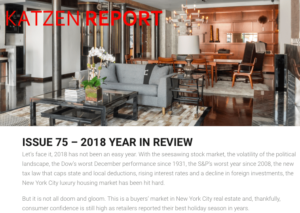Let’s face it, 2018 has not been an easy year. With the seesawing stock market, the volatility of the political landscape, the Dow’s worst December performance since 1931, the S&P’s worst year since 2008, the new tax law that caps state and local deductions, rising interest rates and a decline in foreign investments, the New York City luxury housing market has been hit hard.
But it is not all doom and gloom. This is a buyers’ market in New York City real estate and, thankfully, consumer confidence is still high as retailers reported their best holiday season in years.
As I continue to watch the movement of these markets in the coming months, I felt it relevant to take a look over this past years performance. Geopolitical reckoning had its historic moments that shaped not only 2018 but our future and health of our markets.
The global financial market in review
The financial markets gave us all gray hair in 2018.
World stocks lost nearly $7 trillion this year. Emerging markets were trampled due to the strong US dollar pounding gold and U.S. government bonds. The U.S.-China trade tensions combined with most central banks refocusing on rebuilding versus stimulating decimated the MSCI’s world stocks index by 10 percent.
Many countries are worse off than the US. China, Germany, Turkey and Argentina have seen market loses ranging from 15 to 50 percent. Oil prices plunged 35 percent and cryptocurrencies were decimated (as Bloomberg Businessweek’s recent cover read, “Rhymes with Bitcoin: has crypto hit the fan?”). Stock markets in the US seem to be forecasting a looming recession.
Interest rate hikes
As expected, the Federal Reserve’s latest move raised interest rates a quarter of a percentage point, from 2.25 to 2.5 percent, but lowered the probable number of rate hikes to twice (which, some may argue is two too many).
From a historical standpoint, 2.5 is still low even though it is the highest since the financial crisis a decade ago. Don’t forget, the Fed has raised short-term rates several times, but the 10-year Treasury has fallen materially of late and now is only 25 bp higher than where the year began. Given this rate is tied more closely tied to mortgage rates, this is a supportive development as we move into the new year.
Further positives are that inflation remains in check, the jobless rate is at a historic low, and wages have shown signs of ticking higher. Indeed, the Fed assumes the view that the economy is “robust” and are basing continued rate hikes on “expectations for healthy growth” of the economy.
The changes in the tax reform
There remains a lot of confusion on the overall impacts of tax reform, which certainly has had an effect on buyer behavior. This is in part reasonable because tax reform wasn’t beneficial for most 1) high earners in 2) high tax states that 3) own real estate with high taxes. However, some of the fear has been overblown by the media, who have not the looked at the complete picture: the reform’s lower federal tax rates will offset a great deal of the loss of state and local tax deductions. In fact, when you run the numbers, for many it essentially is a “wash” from an after-tax purchasing power perspective. For those that are worse off (which includes some of the top earners with high state and local tax bills), the percentages in most cases should be fairly small. As such, I believe many will be pleasantly surprised that the reform isn’t quite as punitive as feared when their 2018 tax returns are filed next April.
The 2018 real estate market in review
According to CityRealty’s year-end data report, “After years of soaring prices, Manhattan residential real estate has leveled off with condos showing slight declines in 2018. Total apartment sales over $10 million are projected to reach $4.4 billion by the end of 2018, down from $4.6 billion in 2017. The median sales price of all apartments in 2018 was $1.2 million, down from $1.25 million in 2017. There was a slight decrease in the median price of condos, which fell to $1.72 million from $1.84 million in 2017. Co-ops, however, rose to a median price of $855,000 from $845,000 in 2017.”
The total sales of apartments over $10 million are projected to reach $4.4 billion through the end of 2018, which is only a four percent decline from the previous year at $4.6 billion.
But we cannot ignore that article after article point to the price cuts sellers are forced to accept due to falling demand. Purchase offers are commonly as low as 25% below asking, something not seen since 2009.
A big change in recent years is the true understanding of apartment values within these year-end reports. There was a prevalence of new developments that closed this year and garnered stratospheric high dollar price per square foot which were achieved and signed well over three years ago, thus skewing the actual 2018 sold and closed data. These anomaly stratospheric sale figures boost the current median blended price per square foot. Therefore, it is hard to measure the real actual transactions.
Analyzing closings that have taken place and seeking a median price per square foot in the traditional way is now thwarted. If we simply look at the average sale prices or average per square foot prices, we ignore the true value of the current properties which are harder to measure because of these “big closings” but involve the outrageously inclusive and deluxe build-outs with over-the-top amenities and the world-class soaring views or features inside the apartments that include things such as finishes, materials and location.
It is important to note that a correction in the NYC real estate market began over two years ago. The fact the press and folks that traditionally are uninterested in NYC real estate are now talking about market weakness incessantly very well could suggest we are well through the downturn. This is analogous to the old financial adage “buy the rumor and sell the news”- by the time everyone is talking about something, it’s often old news and ready to shift.
The double whammy: glut and the international sell-off
New York City also has the double whammy of a glut of new condominium developments and the recent sell-off from international buyers from countries with imposed capital controls. In December, the Wall Street Journal reported that “Chinese investors unloaded more than $1 billion in U.S. real estate in the third quarter, extending their recent retreat from hotels, office buildings and other foreign property under pressure from Beijing to reduce debt and curb money sent abroad.” The decrease of foreign investors will have a major impact on the market and prices. Say “dosvidaniya” or “zài jiàn” (goodbye) to foreign investment, for now
The silver lining
In all of this mess and uncertainty, there actually is a silver lining for many… this is now a buyer’s market. With the oversupply of new condos and the lack of foreign buyers, both sellers and developers are much more open and willing to negotiate on price and more buyers are looking to purchase first or second homes and not simply investment properties that create far too many unoccupied ghost buildings.
The Amazon and Google effect
Amazon and Google are both making major investments in our city. Amazon’s November announcement of its HQ2 campus in Long Island City has already influenced local housing prices. On December 17th, Streeteasy reported an immediate rise in home prices in LIC after the Amazon news. LIC is feeling bullish.
With Google’s announcement of their campus investment in Hudson Square, the previous Printing District will continue its growth. In the past few years, the neighborhood has grown in height and number of residences in addition to the large fund that has been set aside to increase the neighborhood’s commercial mix, greenery, and traffic flow. Now, with the news of Google’s investment, the neighborhood is set to soar.
Getting in on the great amenities race
Additionally, we have seen a huge boost to amenities packages which make new developments incredibly appealing as they are selling lifestyles, not just homes. A typical list of amenities included in luxury buildings range from state-of-the-art gyms with spas and hammams, children’s room with programming and 24-hour concierge service to in-building restaurants, porte-cochères and a range of rooms from libraries and wine cellars to extend the use and value of your home.
Location, location, location… everywhere
Another positive is that many more Manhattan neighborhoods fit the “location, location, location” real estate adage as all the residential development has attracted more and better retail and cultural opportunities and fewer “no go” zones. There is not a neighborhood in Manhattan that isn’t filled with cranes and construction workers.
Conclusion
I am a realist and the situation is far from ideal but there are perks – you might just have to look a bit harder to find them.
If you are a seller, perhaps you should be a bit flexible in the timing of your sale, should you have that luxury.
If you are in the market to buy, new developments with massive, lifestyle amenity packages have the greatest value. Get to know the developers, look at their track records and negotiate a price that you can live with. Because now is the time to snap up those homes we have all been drooling over for the past few years.
Despite my desire to don rose-colored glasses, I do not provide false optimism. However, historically, over longer cycles, Manhattan real estate has proven much more resilient than most following periods of weakness. The uncertainty of the financial markets hinge on a small number of decisions from above and the markets can pivot on a dime once again. Additionally, despite a looming recession, consumer confidence is still high. The sentiment surveys are up. Retailers had the best holiday season in years. No one wants a recession. Most of all our current president who does not want a recession as his legacy. For now, I believe in watching closely and participate if a good opportunity presents itself. There is a new future in store for us.

